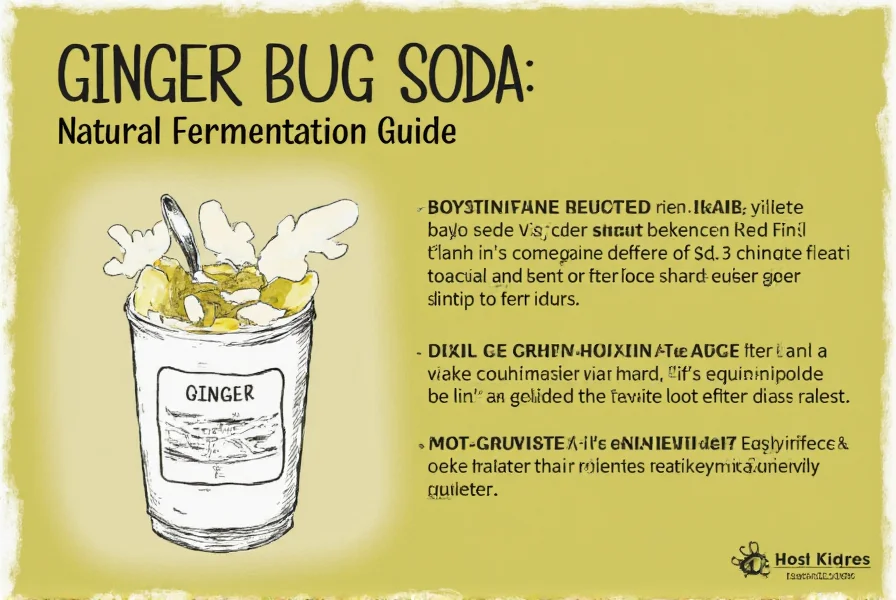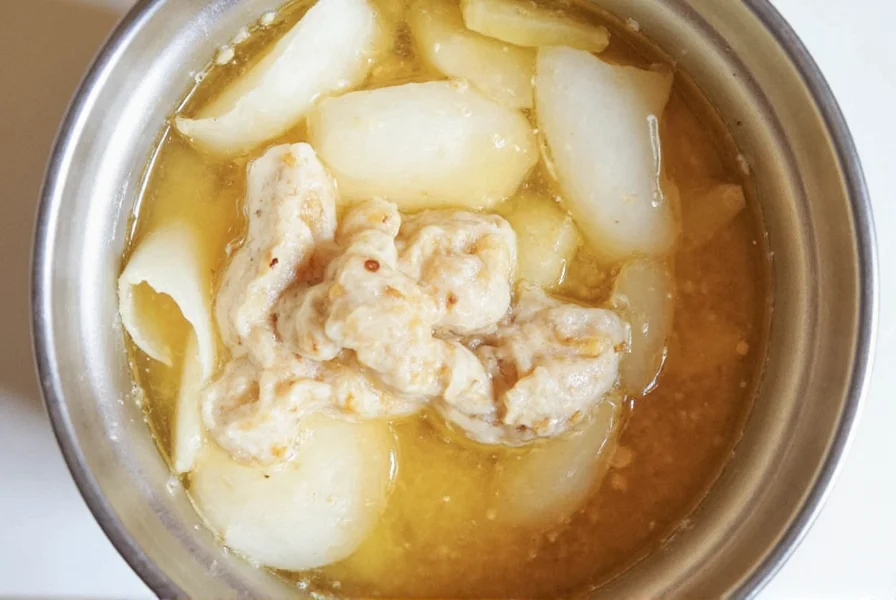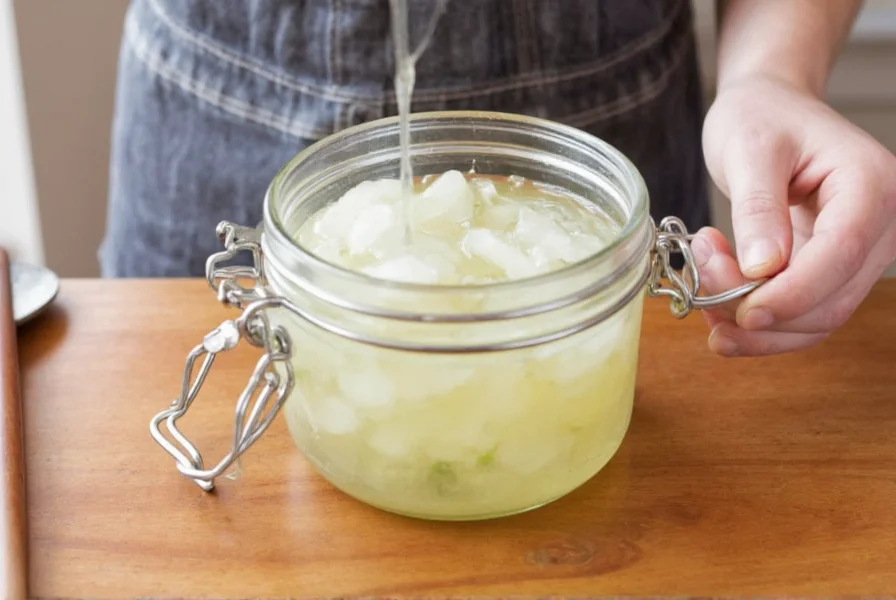Creating ginger bug soda represents one of the simplest entry points into home fermentation. Unlike commercial sodas loaded with artificial ingredients, these naturally carbonated beverages harness wild yeast from fresh ginger to transform simple ingredients into effervescent, probiotic-rich drinks. The process requires minimal equipment and connects modern home brewers with centuries-old fermentation traditions.
What Exactly Is a Ginger Bug?
A ginger bug functions as a living culture starter, similar to a sourdough starter but specifically designed for creating naturally carbonated beverages. This symbiotic culture of wild yeast and bacteria develops when fresh ginger, sugar, and water interact over several days. The microbes consume the sugar, producing carbon dioxide (which creates fizz) and beneficial compounds.
Unlike commercial yeast which provides predictable but单一 fermentation, a ginger bug introduces diverse microbial strains that create complex flavor profiles. This natural fermentation process yields beverages with subtle tanginess, natural sweetness, and satisfying effervescence without artificial carbonation.
| Ingredient | Amount | Purpose |
|---|---|---|
| Fresh organic ginger | 2 tablespoons, grated | Provides wild yeast and nutrients |
| Organic cane sugar | 2 tablespoons | Feeds the microbial culture |
| Filtered water | 2 cups | Creates liquid medium for fermentation |
| Optional: Lemon juice | 1 tablespoon | Acidity regulator and flavor enhancer |
Building Your Ginger Bug Starter: Day-by-Day Process
Creating a robust ginger bug requires patience and consistency. The process typically takes 5-7 days to develop sufficient microbial activity for reliable carbonation.
Days 1-3: Initial Activation
Combine 2 tablespoons grated ginger, 2 tablespoons sugar, and 2 cups filtered water in a clean quart-sized jar. Stir well and cover with a breathable cloth. Each day, feed with 1 tablespoon grated ginger and 1 tablespoon sugar. Stir twice daily. By day 3, you should notice small bubbles forming and a pleasant, slightly spicy aroma.
Days 4-5: Building Strength
Continue daily feedings but increase to 2 tablespoons ginger and 2 tablespoons sugar each day. The mixture should become noticeably bubbly within 10-15 minutes after feeding. This vigorous activity indicates a healthy, active culture ready for soda making.
Troubleshooting Weak Activity
If your ginger bug shows minimal bubbling by day 4:
- Ensure you're using fresh, organic ginger (non-organic may be treated with sprout inhibitors)
- Maintain temperature between 70-75°F (21-24°C)
- Use unchlorinated water (chlorine inhibits microbial growth)
- Stir more frequently (3-4 times daily)
Transforming Your Ginger Bug into Sparkling Soda
Once your ginger bug shows vigorous bubbling within 15 minutes of feeding, it's ready to carbonate your soda. The basic process involves creating a flavorful base, adding the ginger bug, and allowing secondary fermentation.
Basic Ginger Soda Recipe
This foundational recipe yields approximately 1 quart of naturally carbonated ginger soda:
- 4 cups water
- 1/2 cup sugar or honey
- 1/4 cup fresh ginger, grated
- 1/4 teaspoon citric acid or 2 tablespoons lemon juice
- 1/2 cup active ginger bug
Bring water, sweetener, and ginger to a gentle simmer for 10 minutes. Strain and cool to room temperature. Add citric acid and ginger bug. Pour into flip-top bottles, leaving 1-2 inches of headspace. Store at room temperature for 1-3 days until desired carbonation is achieved, then refrigerate.

Flavor Variations for Creative Ginger Bug Sodas
The beauty of ginger bug soda lies in its versatility. Once you've mastered the basic technique, experiment with these natural flavor infusions:
Fruit-Infused Ginger Sodas
Add 1/2 cup of any of these during the syrup-making stage:
- Raspberry or strawberry (creates vibrant pink soda)
- Pineapple chunks (tropical flavor with natural enzymes)
- Blueberry and mint (refreshing summer combination)
- Tart cherry juice (rich color and complex flavor)
Herbal and Botanical Variations
Steep these ingredients with your ginger syrup:
- Lavender and lemon (floral and refreshing)
- Rosemary and grapefruit (sophisticated herbal profile)
- Hibiscus flowers (creates beautiful red color)
- Ginger-turmeric with black pepper (anti-inflammatory boost)
Critical Safety Considerations for Home Fermentation
While ginger bug soda is generally safe, proper technique prevents potential issues:
Identifying Problematic Fermentation
Discard your batch immediately if you notice:
- Visible mold (fuzzy spots of white, green, or black)
- Putrid or rotten odors (healthy fermentation smells pleasantly tangy)
- Pink discoloration (indicates unwanted bacteria)
Bottle Safety Practices
To prevent dangerous pressure buildup:
- Always use proper fermentation bottles (swing-top or plastic soda bottles)
- Burp bottles daily during active fermentation
- Refrigerate after reaching desired carbonation
- Never use glass bottles not designed for pressure
Perfecting Carbonation: Temperature and Timing
Carbonation levels depend on several factors:
| Temperature | Carbonation Time | Result |
|---|---|---|
| 65-70°F (18-21°C) | 3-5 days | Gentle fizz, subtle flavor development |
| 70-75°F (21-24°C) | 1-3 days | Optimal carbonation for most recipes |
| 75-80°F (24-27°C) | 12-24 hours | Rapid carbonation, risk of over-carbonation |
| Above 80°F (27°C) | Less than 12 hours | High risk of bottle explosion |
Test carbonation levels by carefully opening one bottle after 24 hours. If minimal fizz appears, allow additional fermentation time. Once satisfied with carbonation, immediately refrigerate all bottles to slow fermentation.
Troubleshooting Common Ginger Bug Soda Issues
Even experienced fermenters encounter challenges. Here's how to address frequent problems:
Flat Soda (No Carbonation)
Possible causes and solutions:
- Inactive ginger bug - Feed starter for additional 1-2 days
- Too much headspace - Fill bottles leaving only 1-1.5 inches headspace
- Temperature too low - Move to warmer location (70-75°F)
- Sweetener fully consumed - Add 1 teaspoon sugar per bottle before bottling
Overly Sweet Soda
If your soda remains too sweet after fermentation:
- Extend room temperature fermentation time
- Increase ginger bug amount (up to 1 cup per quart)
- Add a pinch of cream of tartar to lower pH and boost fermentation

Storing and Maintaining Your Ginger Bug Culture
Your ginger bug can become a long-term fermentation companion with proper care:
Short-Term Maintenance (1-2 weeks)
Store in the refrigerator with a tight lid. Feed weekly with equal parts ginger and sugar. Allow to sit at room temperature for 4-6 hours after feeding before returning to fridge.
Long-Term Storage (1 month+)
For extended breaks:
- Feed generously (2 tbsp ginger, 2 tbsp sugar)
- Let sit at room temperature for 24 hours
- Transfer to clean jar with tight lid
- Store in refrigerator
- Revive with daily feedings for 3 days before using
Why Ginger Bug Soda Outperforms Commercial Alternatives
Beyond the satisfaction of homemade creation, ginger bug sodas offer distinct advantages:
- Naturally occurring probiotics support digestive health
- No artificial colors, flavors, or preservatives
- Customizable sweetness levels to personal preference
- Lower sugar content than most commercial sodas
- Complex flavor profiles impossible in mass-produced beverages
The traditional ginger bug method connects us with historical beverage traditions while delivering modern health benefits. Each batch develops unique characteristics based on local microbial environment, creating truly personalized sodas that evolve with your skill and experience.
Frequently Asked Questions
How long does it take to make ginger bug soda from start to finish?
Creating ginger bug soda requires approximately 7-10 days total. The ginger bug starter needs 5-7 days of daily feeding to become active. Once ready, transforming it into soda takes 1-3 days of secondary fermentation for carbonation, plus preparation time. The entire process from initial starter to drinkable soda typically spans one to two weeks.
Can I use non-organic ginger for my ginger bug?
While possible, non-organic ginger often contains sprout inhibitors that can prevent successful fermentation. Organic ginger provides the natural microbial life needed for a healthy ginger bug. If only non-organic ginger is available, scrubbing thoroughly and using extra ginger may help overcome potential inhibitors, but results will be less reliable.
Why does my ginger bug soda taste too vinegary?
Excessive vinegar flavor indicates over-fermentation, where bacteria have converted too much sugar into acetic acid. To prevent this, reduce fermentation time, maintain temperatures below 75°F (24°C), and refrigerate sooner once desired carbonation is achieved. Using less ginger bug (1/4 cup instead of 1/2 cup) can also help balance flavors.
How can I make sugar-free ginger bug soda?
Creating completely sugar-free ginger bug soda isn't possible since the microbes need sugar to produce carbonation. However, you can use low-glycemic sweeteners like allulose or monk fruit in the final soda stage after the ginger bug has done its work. The fermentation process will consume most added sugars, leaving minimal residual sugar in properly fermented sodas.
What's the difference between ginger bug and ginger beer plant?
Ginger bug is a temporary culture made fresh for each batch, while ginger beer plant (GBP) is a permanent, reusable SCOBY (symbiotic culture of bacteria and yeast) that resembles small crystals. GBP creates more consistent carbonation and can be maintained indefinitely with proper care, whereas ginger bug requires daily feeding and is typically used within 1-2 weeks of creation.











 浙公网安备
33010002000092号
浙公网安备
33010002000092号 浙B2-20120091-4
浙B2-20120091-4